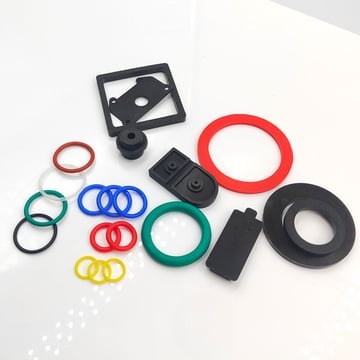Understanding the Difference Between Silicone and Silicone Sealant
Silicone and silicone sealant are two terms often used interchangeably, but they are not the same thing. Understanding their difference is crucial, particularly when buying materials for home repairs, DIY projects, and other applications.
1. Composition
Silicone refers to a class of synthetic polymers with a unique molecular structure. It has a backbone made of alternating silicon and oxygen atoms, with various organic and inorganic groups attached to silicon. Silicone can exist in different forms, including liquids, gels, rubbers, and solids, with varying properties.
Meanwhile, silicone sealant is a specific type of silicone product that is designed for sealing gaps and joints in various surfaces. It typically contains silicone polymer, fillers, additives, and curing agents that make it flexible, durable, and resistant to temperature, moisture, and chemicals.
2. Purpose
Silicone has numerous industrial, commercial, and personal applications, such as adhesives, coatings, lubricants, medical devices, electronics, and cookware. It is known for its high heat resistance, low chemical reactivity, water repellence, and biocompatibility.
On the other hand, silicone sealant is primarily used for sealing and bonding surfaces in construction, automotive, plumbing, and DIY projects. Its main purpose is to provide a flexible and waterproof barrier that can withstand thermal expansion and contraction, vibration, and movement.
3. Appearance
Silicone can come in various colors, depending on its additives and pigments. It can also be transparent or translucent, allowing light to pass through. Silicone can have a smooth or textured surface, and it can be molded into various shapes and sizes.
Silicone sealant, on the other hand, is usually white or clear, but it can also come in other colors, such as black, gray, or brown. It has a thick and viscous consistency that can be applied using a caulking gun or a brush. Once cured, it can have a shiny or matte finish, depending on the formulation.
4. Application
To use silicone, you need to prepare the surface by cleaning it thoroughly and making sure it is dry and free of any dirt, oil, or debris. Then, you can apply the silicone using a dispenser or a brush, depending on the shape and size of the surface. Silicone can take some time to cure, depending on the temperature and humidity.
To use silicone sealant, you need to cut the nozzle of the cartridge at a 45-degree angle and insert it into a caulking gun. Then, you can apply the sealant onto the gaps or joints, smoothing it with a finger or a tool. You need to work quickly and precisely, as silicone sealant can cure faster than silicone and may become hard to mold once dry.
5. Strength and Durability
Silicone is known for its high tensile strength, elongation, and tear resistance, making it suitable for applications that require flexibility and resilience. However, silicone may not be as strong as other materials, such as metal or plastic, and may degrade over time due to exposure to UV light, ozone, or certain chemicals.
Silicone sealant, on the other hand, is designed to be flexible, yet strong enough to resist peeling, cracking, or splitting. It can withstand temperature changes, water immersion, and exposure to sunlight and chemicals, making it ideal for sealing windows, doors, roofs, and other surfaces that are subject to weathering.
6. Safety and Health
Silicone is generally considered safe and non-toxic, as it does not emit harmful fumes or particles during normal use or disposal. However, some types of silicone products may contain chemicals that are hazardous to human health or the environment, such as volatile organic compounds (VOCs), phthalates, or heavy metals.
Silicone sealant is also generally safe and non-toxic, although some formulations may contain solvents or additives that may cause skin or eye irritation or respiratory problems. It is advisable to read the label and follow the instructions carefully to minimize the risk of exposure or allergic reactions.
7. Cost
Silicone products vary in cost, depending on the type, quantity, and brand. Generally, silicone is more expensive than other materials, such as plastic or rubber, due to its unique properties and production process. Silicone products that require high purity or precision may also cost more.
Silicone sealant is relatively inexpensive, compared to other building materials, such as bricks, mortar, or cement. It is readily available in hardware stores, online shops, and home centers, and can be bought in small or large quantities. The cost of silicone sealant may also depend on the brand, quality, and color.
8. Maintenance
Silicone products, including silicone sealant, require minimal maintenance, compared to other materials that may require painting, cleaning, or replacement. Silicone can resist dirt, mildew, and stains, and can be wiped clean with a damp cloth or sponge. However, prolonged exposure to heat, moisture, or UV radiation may affect its performance and appearance.
Silicone sealant, once cured, can last for many years without needing repair or replacement. However, it may develop cracks or gaps due to wear and tear, settling, or weathering. It is advisable to inspect and maintain the sealant regularly, especially in areas that are exposed to extreme conditions, such as roofs, foundations, or joints.
9. Compatibility
Silicone products may not be compatible with all materials, especially those that are porous, oily, or corroded. Silicone may also react with certain chemicals, such as acids, bases, or solvents, or with certain metals, such as copper or brass, that may cause staining or corrosion.
Silicone sealant, on the other hand, is designed to bond and seal a variety of surfaces, including metal, glass, wood, plastic, stone, and concrete. However, some surfaces may require special preparation or priming, such as aluminum or galvanized steel, to ensure proper adhesion.
10. Eco-Friendliness
As a synthetic polymer, silicone is not biodegradable, and it may persist in the environment for a long time if not disposed of properly. However, some silicone products may be recyclable if collected separately and processed accordingly.
Silicone sealant may also have an environmental impact if not used or disposed of properly. Some formulations may contain chemicals that are harmful to aquatic or terrestrial life, such as nonylphenol ethoxylates or organotin compounds. It is advisable to read the label and follow the instructions carefully, and to dispose of the sealant in compliance with local regulations.

